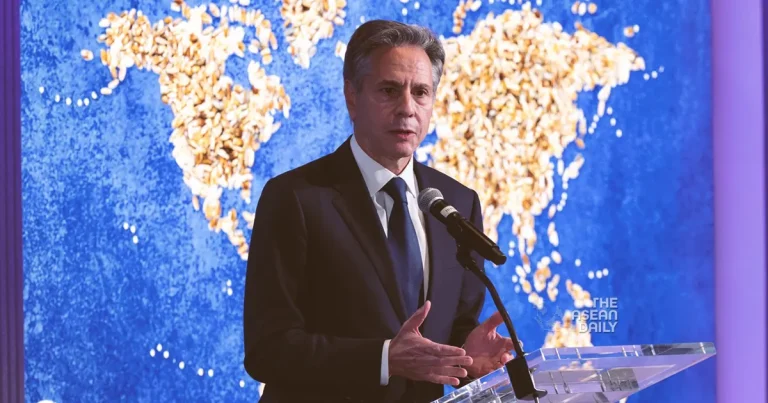25-7-2024 (WASHINGTON) In a move aimed at underscoring the United States’ unwavering commitment to Asia, Secretary of State Antony Blinken is set to embark on a 10-day tour across six countries in the region, starting Thursday. The extensive trip, one of Blinken’s longest foreign visits to date, will take him to Laos, Vietnam, Japan, the Philippines, Singapore, and Mongolia, as Washington seeks to reaffirm its strategic pivot towards the Indo-Pacific.
Daniel Kritenbrink, the assistant secretary of state for East Asian and Pacific affairs, emphasized the significance of the visit, stating that it will demonstrate the U.S.’s “all in” approach to ASEAN (Association of Southeast Asian Nations) as an institution and its partnerships across the region. “We’re building a lattice work … an interlocking network of relationships, formal and informal, that advances our shared interests across the region,” Kritenbrink told a seminar at the American Enterprise Institute on Wednesday.
The Biden administration, which vowed to “focus on every corner of the region” in its 2022 Indo-Pacific Strategy, has been consumed by flare-ups and conflicts in Afghanistan, Ukraine, and Israel, among other global hotspots. Blinken’s 10-day tour aims to redirect attention to America’s biggest strategic challenger, China, according to observers.
Mira Rapp-Hooper, the National Security Council’s senior director for East Asia and Oceania, highlighted the administration’s hope that the region’s minilateral groupings, such as the Quad (U.S., Japan, India, and Australia), the U.S.-Japan-South Korea group, and the U.S.-Japan-Philippines group, will interact with each other to defend the rules-based international order. “It is essentially the creation of a new regional architecture that helps to reinforce the Indo Pacific against all manner of challenges, whether they’re coming from the PRC, the DPRK, climate change, or any number of other threats and challenges,” she said, using the official abbreviations for China and North Korea.
However, even before the trip began, allies were reminded of Blinken’s many hats. Originally, the plan was for him to fly to Vietnam to attend the state funeral of Nguyen Phu Trong, the late leader of the country’s ruling Communist Party. However, due to Blinken’s scheduled attendance at a meeting between President Joe Biden and Israeli Prime Minister Benjamin Netanyahu on Thursday morning, the secretary will now miss the funeral and instead pay respects to Trong’s family a day later.
Vietnam, described by Deputy Secretary of State Kurt Campbell as an Indo-Pacific “swing state,” has been likened to the crucial battleground states of the U.S. presidential election. Just as those states will decide the next American leader in November, who Vietnam supports is expected to be a major factor in the U.S.-China competition for influence in the Indo-Pacific. Attending the funeral for China is Wang Huning, the fourth-highest ranking member of the Chinese Communist Party’s Politburo Standing Committee.
While in Laos, Blinken will have a meeting with Chinese Foreign Minister Wang Yi on the sidelines of the East Asia Summit foreign ministers’ meeting and the ASEAN Regional Forum (ARF) foreign ministers’ meeting.
On Sunday, Blinken will be joined by U.S. Defense Secretary Lloyd Austin in Tokyo for a “two-plus-two” dialogue of foreign and defense ministers. The two sides will follow up on the April summit between Biden and Japanese Prime Minister Fumio Kishida in Washington, and put into action the measures agreed upon by the leaders to strengthen the U.S.-Japan alliance.
One key item on the agenda will be the revamp of the command and control structure of U.S. forces in Japan. While the rank of the commander, the location of the operational command, and the size of the staff have yet to be decided, James Schoff, a senior director at the Sasakawa Peace Foundation USA, emphasized the importance of clarity on this initiative during the two-plus-two meeting.
Ely Ratner, the U.S. assistant secretary of defense for Indo-Pacific security affairs, stated that the two sides will also discuss force posture in Japan, “in particular in the Southwest Islands, to think about how we can expand our cooperation there.” Japan’s Southwest Islands are a chain that stretches southwest from the Kyushu region to Taiwan, and any increased activity in the vicinity is sure to attract China’s attention.
On Monday, Blinken will attend a Quad foreign ministers’ meeting in Tokyo, the eighth such gathering. The meeting will pave the way for a leaders’ meeting in India this year, although Biden’s health may determine whether he can make the foreign visit.
Camille Dawson, the deputy assistant secretary of state for East Asian and Pacific affairs, stated that the four-way grouping will seek to bolster economic security. “One of the most critical ways we think that the Quad can support the region is in terms of economic security and building up the economic resilience that enables them to most effectively move in a prosperous direction,” she said at a Foreign Press Center briefing.
Blinken and Austin will then travel to Manila to hold a two-plus-two meeting with their Philippine counterparts, where discussions on measures to maintain security in the South China Sea are expected to take place.




